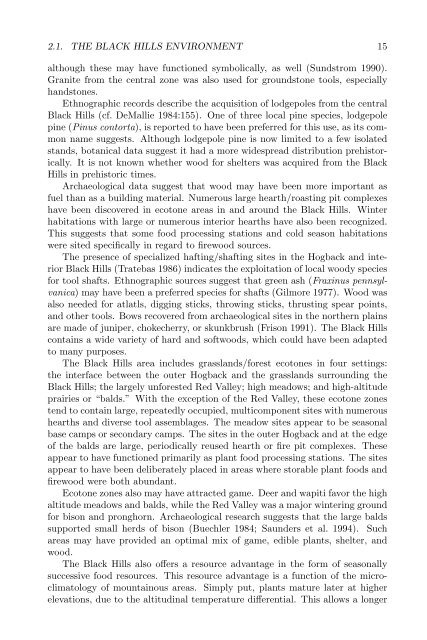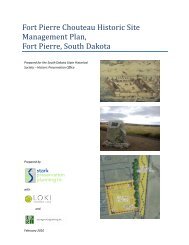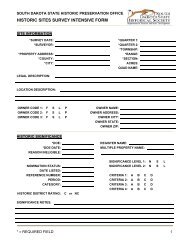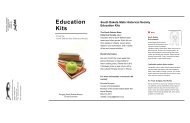The Blaine Site - South Dakota State Historical Society
The Blaine Site - South Dakota State Historical Society
The Blaine Site - South Dakota State Historical Society
You also want an ePaper? Increase the reach of your titles
YUMPU automatically turns print PDFs into web optimized ePapers that Google loves.
2.1. THE BLACK HILLS ENVIRONMENT 15<br />
although these may have functioned symbolically, as well (Sundstrom 1990).<br />
Granite from the central zone was also used for groundstone tools, especially<br />
handstones.<br />
Ethnographic records describe the acquisition of lodgepoles from the central<br />
Black Hills (cf. DeMallie 1984:155). One of three local pine species, lodgepole<br />
pine (Pinus contorta), is reported to have been preferred for this use, as its common<br />
name suggests. Although lodgepole pine is now limited to a few isolated<br />
stands, botanical data suggest it had a more widespread distribution prehistorically.<br />
It is not known whether wood for shelters was acquired from the Black<br />
Hills in prehistoric times.<br />
Archaeological data suggest that wood may have been more important as<br />
fuel than as a building material. Numerous large hearth/roasting pit complexes<br />
have been discovered in ecotone areas in and around the Black Hills. Winter<br />
habitations with large or numerous interior hearths have also been recognized.<br />
This suggests that some food processing stations and cold season habitations<br />
were sited specifically in regard to firewood sources.<br />
<strong>The</strong> presence of specialized hafting/shafting sites in the Hogback and interior<br />
Black Hills (Tratebas 1986) indicates the exploitation of local woody species<br />
for tool shafts. Ethnographic sources suggest that green ash (Fraxinus pennsylvanica)<br />
may have been a preferred species for shafts (Gilmore 1977). Wood was<br />
also needed for atlatls, digging sticks, throwing sticks, thrusting spear points,<br />
and other tools. Bows recovered from archaeological sites in the northern plains<br />
are made of juniper, chokecherry, or skunkbrush (Frison 1991). <strong>The</strong> Black Hills<br />
contains a wide variety of hard and softwoods, which could have been adapted<br />
to many purposes.<br />
<strong>The</strong> Black Hills area includes grasslands/forest ecotones in four settings:<br />
the interface between the outer Hogback and the grasslands surrounding the<br />
Black Hills; the largely unforested Red Valley; high meadows; and high-altitude<br />
prairies or “balds.” With the exception of the Red Valley, these ecotone zones<br />
tend to contain large, repeatedly occupied, multicomponent sites with numerous<br />
hearths and diverse tool assemblages. <strong>The</strong> meadow sites appear to be seasonal<br />
base camps or secondary camps. <strong>The</strong> sites in the outer Hogback and at the edge<br />
of the balds are large, periodically reused hearth or fire pit complexes. <strong>The</strong>se<br />
appear to have functioned primarily as plant food processing stations. <strong>The</strong> sites<br />
appear to have been deliberately placed in areas where storable plant foods and<br />
firewood were both abundant.<br />
Ecotone zones also may have attracted game. Deer and wapiti favor the high<br />
altitude meadows and balds, while the Red Valley was a major wintering ground<br />
for bison and pronghorn. Archaeological research suggests that the large balds<br />
supported small herds of bison (Buechler 1984; Saunders et al. 1994). Such<br />
areas may have provided an optimal mix of game, edible plants, shelter, and<br />
wood.<br />
<strong>The</strong> Black Hills also offers a resource advantage in the form of seasonally<br />
successive food resources. This resource advantage is a function of the microclimatology<br />
of mountainous areas. Simply put, plants mature later at higher<br />
elevations, due to the altitudinal temperature differential. This allows a longer
















